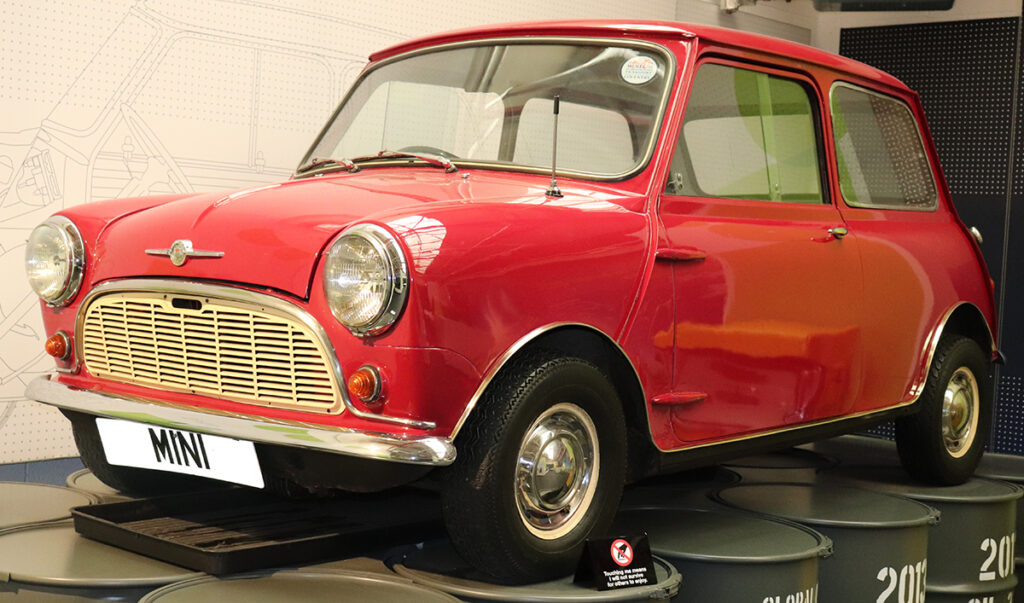
Classic Mini Mark I borne out of a Fuel Crisis
The Mini Mark I, a car borne out of the Suez Crisis
In 2026, the classic Mini celebrates the 70th anniversary of the car’s inception. An incredible achievement for a car borne out of adversity.
The 1956 British-French-Israeli invasion of Egypt, otherwise known as the Suez Crisis, caused fuel shortages across the world. Petrol rationing in the United Kingdom resulted in a rise in the popularity of “bubble cars”, as originally developed by Italian motorcycle manufacturer Iso and, after buying the rights, sold by car manufacturers including BMW. This change in motorists purchasing behaviour sparked the British Motor Corporation (BMC) into action. And so the concept of the Mini Mark I was conceived.

BMC’s chairman, Sir Leonard Lord, turned to British-Greek automotive designer Alec Issigonis to create a compact car that could comfortably seat four passengers. This small, fuel-efficient and affordable car would then compete with the popular “bubble cars”.
The proposed engine size was originally 948 cc, as used in the Morris Minor and Austin A35. However, Sir Leonard Lord thought that the 90 mph (140 km/h) top speed was excessive and thus reduced the engine size to 848 cc to gain a more manageable speed (for the time) of 72 mph (116 km/h).
An Austin deluxe saloon was tested by the British magazine The Motor in 1959. The tests recorded a top speed of 72.4 mph (116.5 km/h) with acceleration from 0–60 mph (97 km/h) in 27.1 seconds. The all-important fuel consumption registered 43.5 mpg‑imp (6.49 L/100 km; 36.2 mpg‑US). The test car cost £537, which included taxes of £158.
Finally, in April 1959, the first post-prototype, pre-production Minis were assembled at the BMC’s Austin plant in Longbridge, Birmingham. On August 26, 1959 the new Austin Seven and Morris Mini Minor were officially unveiled to the public.
Feedback from the motoring press was very positive, praising the revolutionary design features such as the transverse-mounted engine, front-wheel drive, and compact dimensions that allowed for 80% of the floorplan to be used for passengers and luggage.
Reviewers found the Mini smooth, easy to drive, and noted the impressive handling and stable driving experience, even on poor road surfaces, due to the car’s low centre of gravity and innovative rubber suspension.
The motoring press considered the Mini an outstanding and sophisticated car at such a competitive price. Industry experts recognised the Mini as a technical masterpiece and a game-changer.

However, the public response was less enthusiastic with a general scepticism and hesitancy to embrace the radical design. Many Britons were unconvinced by the unfamiliar front-wheel-drive concept and the car’s small size, preferring “real-size” traditional saloons.
Sales struggled, with only around 8,000 cars sold in the first year. Gradually, opinions changed and motorists started to see the potential of this revolutionary small car. Celebrities, film stars, pop stars, and even royalty fell in love with this new small car. Suddenly, the Mini was an icon of 1960s popular culture. Success in motorsports, particularly the Monte Carlo rally, further boosted the car’s popularity.
Between 1959 and 1969, it is estimated that 1.1 million Mark I Minis left the production lines in Longbridge, UK and, after 1967, in Australia. As of 2025, data shows that there are approximately 1,900 Austin Mini Mark I cars licensed and on the road in the United Kingdom.
In 1999, The Mini was voted the second most influential car of the 20th century.
Smiths Instruments had a long-running relationship with BMC designing and supplying gauges for cars such as the Morris Minor, Morris Oxford and Austin Cambridge. For the new small car, BMC turned to Smiths. With the focus on minimising costs, the only gauge was a speedometer with integral fuel gauge. This was mounted centrally in the car dashboard.

As the Mini developed, with new models such as the Mini Cooper, other gauges were included such as tachometers and clocks. CAI continue to manufacture replacement gauges for the Mini Mark I using the original drawings and work instructions. CAI have also developed updated electronic versions of mechanical gauges, including an electronic version of the speedometer driven by changes in available drive trains and emissions-driven engine changes.
For further information on Smiths gauges for classic Minis please contact us on:
Email: [email protected]
Phone: +44 (0) 1639 732200
You can also follow us on social media for regular news updates, photographs and technical information: